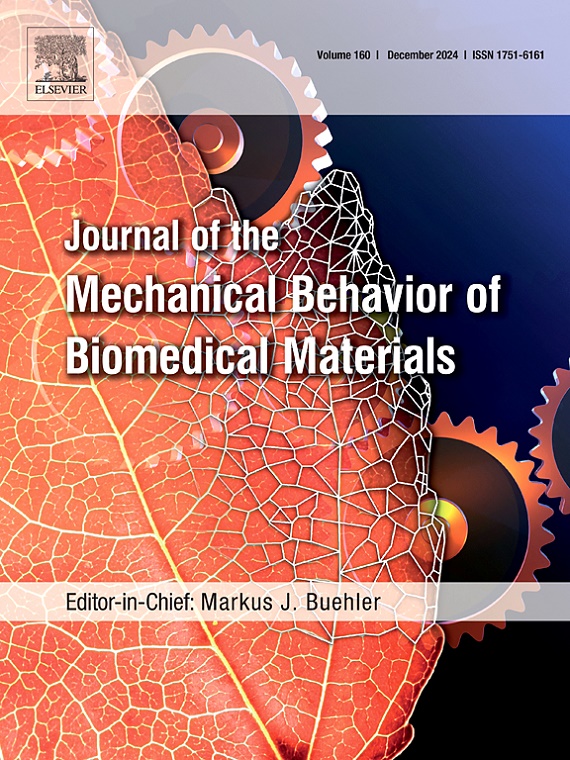由AFM力松弛和力-距离曲线确定软质材料的孔弹性和粘弹性特性。
IF 3.3
2区 医学
Q2 ENGINEERING, BIOMEDICAL
Journal of the Mechanical Behavior of Biomedical Materials
Pub Date : 2024-12-09
DOI:10.1016/j.jmbbm.2024.106865
引用次数: 0
摘要
在组织工程领域,确定水凝胶的力学特性是开发模拟细胞外基质特性的生物材料的关键先决条件。在机械生物学中,理解细胞的力学特性和生理状态之间的关系也是必不可少的。这些软质材料的力学特性通常是通过在液体环境中的原子力显微镜(AFM)实验来实现的。然而,确定一个合适的模型来正确解释实验数据往往是缺失的,这使得难以提取定量的力学性能。在应用相关的孔隙弹性或粘弹性理论对曲线进行建模之前,将力松弛和力-距离曲线结合起来阐明了水凝胶和细胞中耗散过程的起源。利用球面AFM针尖,建立了解析方程,描述了施加的力与半无限和有限厚度材料的弹性、孔弹性或粘弹性响应之间的关系,将这些曲线转化为力学参数。证明了热响应型水凝胶的孔隙弹性行为,并从力松弛曲线中提取了一组孔隙弹性参数。相比之下,细胞表现出粘弹性特性,其特征是在30年的时间尺度上出现单一幂律松弛。此外,通过拟合力松弛曲线和接近-收缩力-距离曲线,得到了细胞的压缩模量和流动性指数。这种理论与实验相结合的框架通过(1)系统地确定其松弛机制的起源,(2)定义理论模型以正确解释实验数据,(3)使用解析解方程提取力学参数,为软质材料的定量力学特性开辟了一条严谨的道路。本文章由计算机程序翻译,如有差异,请以英文原文为准。

Poroelastic and viscoelastic properties of soft materials determined from AFM force relaxation and force-distance curves
In the field of tissue engineering, determining the mechanical properties of hydrogels is a key prerequisite to develop biomaterials mimicking the properties of the extracellular matrix. In mechanobiology, understanding the relationships between the mechanical properties and physiological state of cells is also essential. Time-dependent mechanical characterization of these soft materials is commonly achieved by atomic force microscopy (AFM) experiments in liquid environment. However, the determination of an appropriate model to correctly interpret the experimental data is often missing, making it difficult to extract quantitative mechanical properties. Here, force relaxation and force-distance curves were combined to elucidate the origin of dissipative processes involved in hydrogels and cells, before applying the relevant poroelastic or viscoelastic theory to model the curves. By using spherical AFM tips, analytical equations were developed to transform these curves into mechanical parameters by describing the relationships between the exerted force and the elastic, poroelastic or viscoelastic responses of semi-infinite and finite-thickness materials. Poroelastic behavior was evidenced for a thermoresponsive hydrogel and a set of poroelastic parameters was extracted from the force relaxation curves. In contrast, cells exhibited viscoelastic properties characterized by a single power-law relaxation over three-decade time scales. In addition, compressive modulus and fluidity exponent of cells were obtained by fitting force relaxation curves and approach-retraction force-distance curves. This combined theoretical and experimental framework opens a rigorous way toward quantitative mechanical properties of soft materials by (1) systematically determining the origin of their relaxation mechanisms, (2) defining the theoretical models to correctly interpret the experimental data, (3) using analytically solved equations to extract the mechanical parameters.
求助全文
通过发布文献求助,成功后即可免费获取论文全文。
去求助
来源期刊

Journal of the Mechanical Behavior of Biomedical Materials
工程技术-材料科学:生物材料
CiteScore
7.20
自引率
7.70%
发文量
505
审稿时长
46 days
期刊介绍:
The Journal of the Mechanical Behavior of Biomedical Materials is concerned with the mechanical deformation, damage and failure under applied forces, of biological material (at the tissue, cellular and molecular levels) and of biomaterials, i.e. those materials which are designed to mimic or replace biological materials.
The primary focus of the journal is the synthesis of materials science, biology, and medical and dental science. Reports of fundamental scientific investigations are welcome, as are articles concerned with the practical application of materials in medical devices. Both experimental and theoretical work is of interest; theoretical papers will normally include comparison of predictions with experimental data, though we recognize that this may not always be appropriate. The journal also publishes technical notes concerned with emerging experimental or theoretical techniques, letters to the editor and, by invitation, review articles and papers describing existing techniques for the benefit of an interdisciplinary readership.
 求助内容:
求助内容: 应助结果提醒方式:
应助结果提醒方式:


